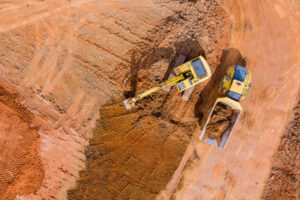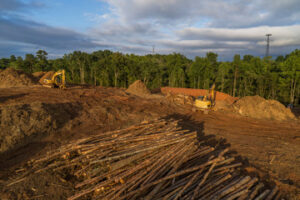Excavating contractors play a crucial role in construction projects. They prepare sites by removing soil and debris.

Their work ensures stable foundations for buildings and infrastructure. Modern techniques are enhancing the efficiency and precision of excavation work. Contact Bar T Excavation, LLC for professional help.
Site preparation is the foundation of successful excavation. Contractors assess soil composition and terrain stability. They identify potential obstacles and design solutions. Proper site preparation reduces project delays and safety risks.
Advanced excavation equipment improves precision and speed. Modern machinery includes GPS-guided excavators and automated systems. These tools enhance accuracy and reduce material waste. Improved equipment increases overall project efficiency.
Safety is a top priority in excavation work. Contractors implement protective measures to prevent soil collapse and equipment accidents. Safety training ensures proper handling of machinery and materials. Protective barriers and monitoring systems enhance site security.
Excavation involves more than digging. Contractors manage grading, leveling, and soil compaction. Proper grading prevents drainage issues and soil erosion. Compacting soil ensures a stable base for construction.
Environmental impact is carefully managed during excavation. Contractors develop erosion control and sediment management plans. Preserving natural habitats is prioritized. Sustainable practices reduce environmental disruption.
Excavation projects require careful coordination with other contractors. Utility lines and underground structures must be identified and protected. Collaboration prevents damage and costly repairs. Efficient planning reduces project delays.
Trenching is a common excavation method used for utility installation. Trenches require shoring and reinforcement to prevent collapse. Proper slope angles and soil support improve trench stability. Trenching safety protocols are strictly enforced.
Rock excavation involves specialized equipment and techniques. Contractors use hydraulic breakers and explosives when necessary. Controlled blasting minimizes vibration and structural damage. Rock removal allows for smooth foundation work.
Excavation for road construction requires precise grading and soil stabilization. Contractors adjust soil composition to improve load-bearing capacity. Drainage systems are integrated into the excavation plan. Proper grading ensures smooth and durable road surfaces.
Foundation excavation requires detailed soil analysis and load calculations. Contractors remove unsuitable material and replace it with compacted fill. This process ensures even weight distribution. Stable foundations prevent structural shifting and damage.
Excavation for drainage systems involves strategic planning. Contractors design slopes and channels to direct water flow. Drainage structures are installed to prevent soil erosion. Proper drainage reduces long-term maintenance costs.
Earthmoving projects require large-scale equipment and strategic planning. Contractors balance soil removal and redistribution. Cut and fill methods reduce the need for off-site material disposal. Earthmoving improves site stability and usability.
Pipeline excavation involves precision and careful soil handling. Contractors excavate trenches to specific depths and angles. Protective materials are placed around pipes to prevent damage. Pipeline alignment is verified before backfilling.
Land clearing is an essential part of excavation projects. Contractors remove trees, roots, and debris. Vegetation removal is carefully managed to reduce environmental impact. Cleared land is prepared for construction and landscaping.
Excavation for utility installation requires close coordination with engineers. Contractors follow detailed plans to avoid damaging existing lines. Utility trenches are reinforced and insulated. Accurate installation ensures reliable utility access.
Excavation in urban areas presents unique challenges. Contractors work within limited space and traffic constraints. Noise and dust control measures are implemented. Urban excavation requires detailed planning and communication with local authorities.
Water table management is critical in excavation projects. Contractors install dewatering systems to control groundwater levels. Proper drainage prevents soil instability and equipment flooding. Dewatering supports stable excavation conditions.
Backfilling is an important step in excavation projects. Contractors use compacted soil and engineered fill to stabilize excavated areas. Backfilling improves load distribution and prevents settlement. Proper compaction ensures long-term structural integrity.
Excavation in contaminated soil requires specialized handling. Contractors implement soil testing and contamination removal protocols. Hazardous materials are safely disposed of according to regulations. Clean soil is used to replace contaminated material.
Slope stabilization prevents soil erosion and structural instability. Contractors use retaining walls, geotextiles, and vegetation to reinforce slopes. Proper slope grading improves drainage and soil retention. Stabilization techniques ensure long-term site stability.
Excavation for landscaping projects involves detailed grading and soil preparation. Contractors create slopes and contours to enhance drainage and aesthetics. Proper soil preparation supports healthy plant growth. Landscaping excavation improves site usability and appearance.
Excavation in high-risk areas requires specialized equipment and techniques. Contractors assess soil stability and potential hazards. Protective barriers and shoring systems are used to prevent collapse. Risk management ensures safe excavation conditions.
Advanced mapping and surveying improve excavation accuracy. Contractors use 3D modeling and laser scanning to assess site conditions. Survey data guides excavation plans and equipment positioning. Accurate mapping reduces material waste and improves efficiency.
Excavation in flood-prone areas requires detailed water management plans. Contractors design drainage channels and retention basins. Reinforced barriers protect against water infiltration. Proper water management reduces flood damage risks.
Excavation for underground structures requires reinforced support systems. Contractors install concrete walls and steel reinforcements. Underground excavation demands precise measurements and alignment. Reinforced structures prevent collapse and water infiltration.
Soil testing is a critical part of excavation planning. Contractors analyze soil composition and load-bearing capacity. Test results guide excavation depth and material selection. Proper soil analysis ensures stable construction foundations.
Excavation for bridge foundations requires deep soil removal and reinforcement. Contractors install piers and supports in bedrock or stable soil layers. Foundation depth and material strength are carefully calculated. Proper support ensures bridge stability and longevity.
Excavation for agricultural projects involves soil grading and drainage improvement. Contractors remove excess soil and improve nutrient levels. Irrigation channels are designed to support consistent water flow. Proper grading enhances crop growth and soil health.
Excavation for airport construction requires precise grading and compaction. Runway foundations demand stable soil and drainage systems. Contractors use heavy machinery for large-scale soil removal and redistribution. Proper grading ensures safe and durable surfaces.
Excavation in sensitive ecological areas requires environmental protection measures. Contractors install silt fences and erosion control mats. Work schedules are adjusted to minimize disruption to wildlife. Environmental monitoring ensures compliance with regulations.
Excavation for renewable energy projects requires specialized foundation work. Contractors install reinforced platforms and soil anchors. Load calculations determine foundation depth and strength. Stable foundations support wind turbines and solar panels.
Excavation for dam construction involves large-scale earthmoving and soil compaction. Contractors create stable embankments and water diversion channels. Soil layers are reinforced with geotextiles and concrete. Proper compaction ensures structural integrity and water retention.
Excavation for railways involves precise alignment and grading. Contractors remove soil and rock to create stable railbeds. Drainage channels are installed to prevent water accumulation. Proper grading ensures smooth and stable track surfaces.
Excavation for mining projects involves deep soil and rock removal. Contractors use heavy machinery and blasting techniques. Mineral-rich soil is separated from waste material. Safety and environmental protocols are strictly followed.
Excavation for ports and harbors involves underwater and shoreline work. Contractors dredge sediment and reinforce embankments. Water flow and sediment patterns are carefully managed. Stable foundations support docks and shipping infrastructure.
Excavation for oil and gas projects requires reinforced trenching and pipeline support. Contractors install protective materials around pipes and equipment. Soil stability and load distribution are carefully calculated. Proper excavation ensures long-term infrastructure performance.
Excavation for utility upgrades requires precision and coordination. Contractors identify and mark existing lines before digging. Trenching and backfilling are carefully managed to prevent damage. Accurate excavation supports long-term infrastructure reliability.
Excavation for large-scale construction projects requires strategic planning and coordination. Contractors manage soil removal, grading, and site preparation. Efficient planning reduces project costs and completion time. Proper site preparation supports structural integrity and performance.
